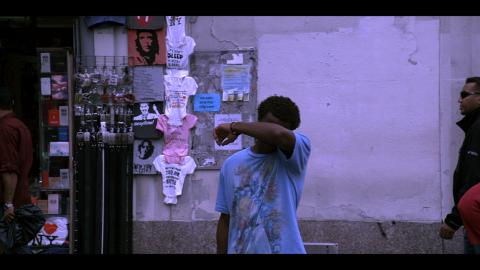
The exhibition opens with a special Schnitzer Cinema, “Motion Studies: The Films and Paintings of James Nares,” on Wednesday, May 10, at 7 p.m.
EUGENE, Ore. -- (April 26, 2017) – The Jordan Schnitzer Museum of Art at the University of Oregon opens “James Nares: Street and Pendulum” in its Artist Project Space. On view from May 10 to September 3, 2017, the exhibition, organized by Richard Herskowitz, JSMA’s curator of media arts, features two video works filmed by Nares in the streets of New York in two different eras.
On Wednesday, May 10, at 7 p.m., Schnitzer Cinema’s “In the Street” series concludes with "Motion Studies: The Films and Paintings of James Nares.” By Skype, Nares will present and discuss his paintings and several of his short films and videos, starting with three films from 1976 -- “Roof,” “Game,” and “Poles” -- to the more recent “To Make a Prairie” created in 2010. The program is free and includes refreshments.
“Street” and Pendulum” represent the early and late stages of Nares’s career. Filmed in 1976, “Pendulum” was shot in black-and-white Super 8 and follows a wrecking ball swinging slowly back and forth down an alley in TriBeCa, home to many New York artists and galleries. In “Artnet News”, art critic Blake Gopnick wrote “’Pendulum’ once spoke of the abandonment of much of New York; there were whole neighborhoods where an artist could swing a giant sphere without anyone much noticing. Its wrecking ball stood for decay and demolition, and for disappearing heavy-metal technologies. Seen today, however, it seems to speak of the destruction, and posh reconstruction, of the very urban fabric where it once could swing free. The film seems to predict the loss of the setting that gave it life."
Filmed in 2011, “Street,” a mesmerizing slow-motion study of New York street life, lovingly freezes hundreds of New York’s culturally diverse denizens as individual portraits within the teeming urban environment. Shot with a high-speed Phantom Flex HD camera usually used to capture fast-action objects, the artist mounted the camera in the rear of an SUV and spent six days perusing the city for ideal locations, free of parked cars and where he could accelerate to up to 30 miles per hour. The sixteen hours of captured footage was edited down to the final 61-minute piece scored with a twelve-string guitar composition by Thurston Moore of Sonic Youth. The video was acquired by the Metropolitan Museum of Art and presented as the centerpiece of a 2013 exhibition that Nares curated for the museum from their collection of street photography.
On watching “Street” Nares says, “There’s a beauty in the dignity of everyone in the film and it just feels good to me to feel this love for humanity. It sounds so corny, because any one of those people could have some ghastly side to them, but for a brief moment I can suspend all of that and just enjoy being part of this world and being part of New York City.”
Born in London in 1953, Nares has lived in New York City since 1974. He attended the Chelsea Art School in London (1972-73) and the School of Visual Arts in New York (1974-76). His work is in numerous public and private collections, including the Museum of Modern Art, the Whitney Museum of American Art, and the Albright-Knox Art Gallery. In 2008, Anthology Film Archives hosted a complete retrospective of his films and videos. In spring 2014, Rizzoli published the first monograph dedicated to James Nares’s work from his four decade career.
This exhibition and related programs are made possible with support from the Office of Academic Affairs and a JSMA Academic Support grant.
About the Jordan Schnitzer Museum of Art
The University of Oregon's Jordan Schnitzer Museum of Art is a premier Pacific Northwest museum for exhibitions and collections of historic and contemporary art. The mission of the museum is to enhance the University of Oregon’s academic mission and to further the appreciation and enjoyment of the visual arts for the general public. The JSMA features significant collections galleries devoted to art from China, Japan, Korea, Europe, and the Americas as well as changing special exhibition galleries. The JSMA is one of seven museums—and the only academic art museum-- in Oregon accredited by the American Alliance of Museums.
The Jordan Schnitzer Museum of Art is located on the University of Oregon campus at 1430 Johnson Lane. Museum hours are 11 a.m. to 8 p.m. Wednesdays, and 11 a.m. to 5 p.m. Thursdays through Sundays. Admission is $5 for adults and $3 for senior citizens. Free admission is given to ages 18 and under, JSMA members, college students with ID, and University of Oregon faculty, staff and students. For information, contact the JSMA, 541-346-3027
Contact: Debbie Williamson Smith, 541-346-0942, debbiews@uoregon.edu
Links: Jordan Schnitzer Museum of Art, http://jsma.uoregon.edu






